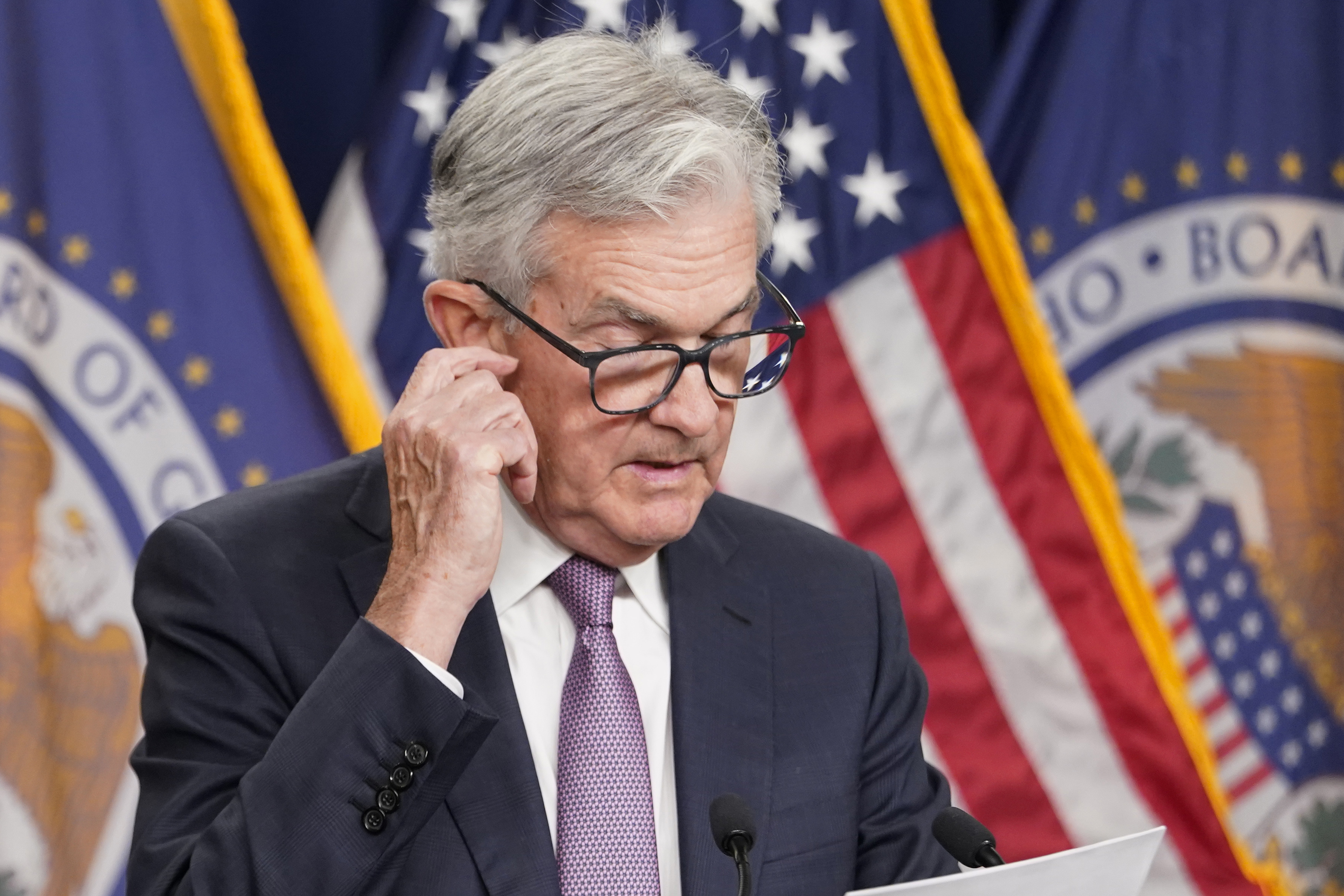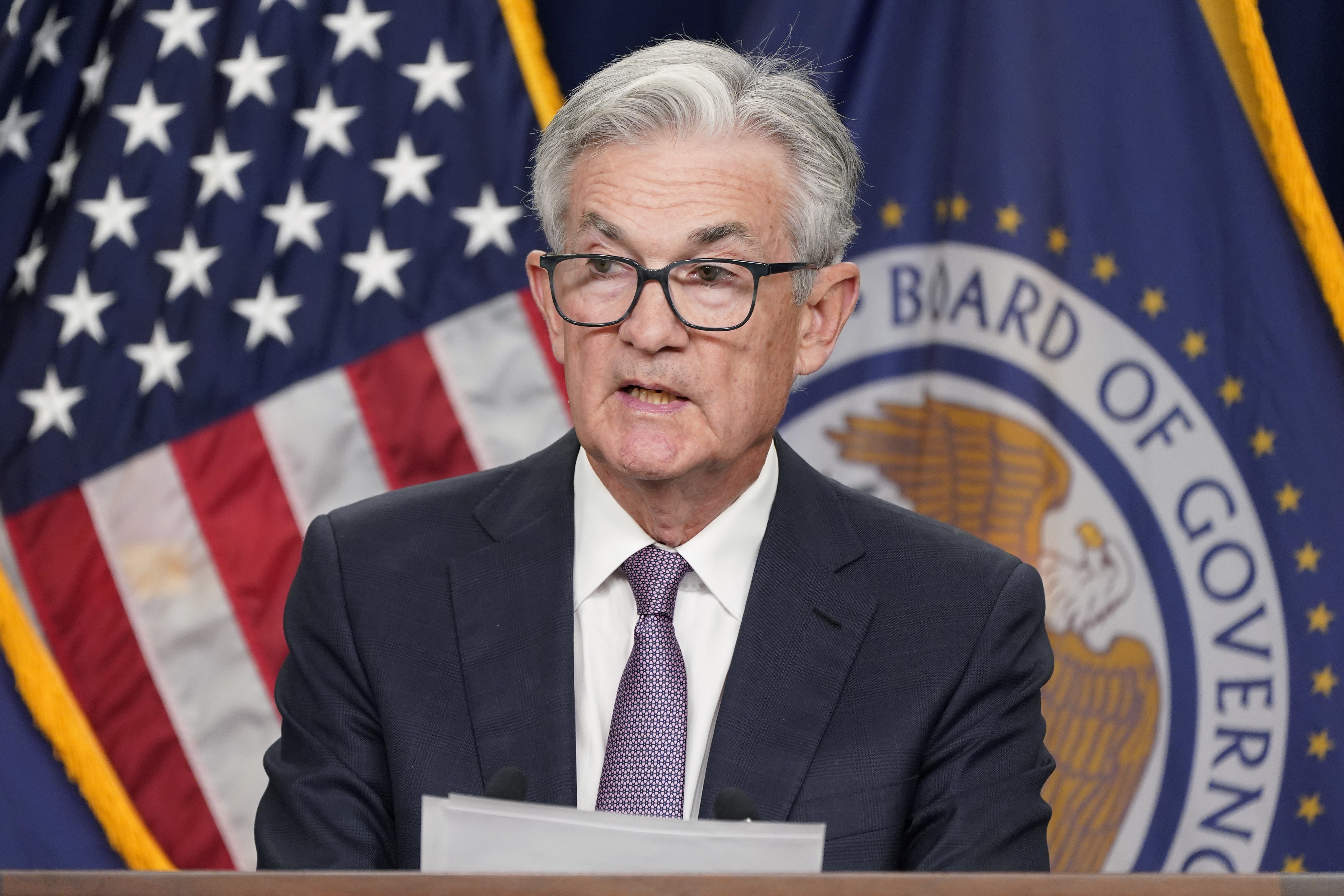Federal Reserve officials ramped up their battle against the fastest inflation in 40 years Wednesday, ushering in a third straight three-quarter point rate increase while projecting a more aggressive path ahead for U.S. monetary policy -- one that is expected to lift interest rates higher and keep them elevated.
The Fed's unanimous move boosted its benchmark short-term rate, which affects many consumer and business loans, to a range of 3% to 3.25%, the highest level since early 2008.
Fed policymakers now also forecast that they will further raise the benchmark rate to roughly 4.4% by year's end, a full percentage point higher than they had prescribed as recently as June. And they expect to raise the rate even further next year, to about 4.6%. That would be the highest level since 2007.
Rates had been forecast to step down to 3.9% in 2024 and 2.9% by 2025.
In a statement after a two-day meeting in Washington, officials led by Fed Chair Jerome Powell repeated that they are "highly attentive to inflation risks." They also reiterated the central bank "anticipates that ongoing increases in the target range will be appropriate," and "is strongly committed to returning inflation to its 2% objective."
Powell noted that the strength of the job market is fueling wage gains that are helping drive up inflation.
The central bank's action Wednesday came after a government report last week that showed high costs spreading more broadly through the economy. By raising borrowing rates, the Fed makes it costlier to take out a mortgage, or an auto or business loan. Consumers and businesses then presumably borrow and spend less, cooling the economy and slowing inflation.
In Wednesday trading, stocks ebbed and flowed ahead of the rate increase but ultimately tumbled at news of the monetary policy. The Dow Jones Industrial Average lost 522.45 points, or 1.7%, while the S&P 500 closed down 66 points, or 1.7%. The Nasdaq fell 204.86 points, or 1.8%.
RECESSION FEARS
Fed officials have said they are seeking a "soft landing," by which they would manage to slow growth enough to tame inflation but not so much as to trigger a recession. Yet most economists say they think the Fed's steep rate increases will lead, over time, to job cuts, rising unemployment and a full-blown recession late this year or early 2023.
"No one knows whether this process will lead to a recession, or if so, how significant that recession would be," Powell said at a news conference Wednesday afternoon. "That's going to depend on how quickly we bring down inflation."
In updated economic forecasts, the Fed's policymakers project that economic growth will remain weak -- marked down to 1.2% in 2023 and 1.7% in 2024, reflecting a bigger impact from tighter monetary policy -- with rising unemployment.
The central bank expects the U.S. jobless rate to reach 4.4% by the end of 2023, up from its current level of 3.7%. Historically, economists say, any time the unemployment rate has risen by a half-point over several months, a recession has always followed.
And even with the steep rate increases the Fed foresees, the central bank still expects core inflation -- which excludes the volatile food and gas categories -- to be 3.1% at the end of next year, well above its 2% target.
Powell acknowledged in a speech last month that the Fed's moves will "bring some pain" to households and businesses. And he added that the central bank's commitment to bringing inflation back down to its 2% target was "unconditional."
Falling gas prices have slightly lowered consumer inflation, which was a still-painful 8.3% in August compared with a year earlier. Inflation peaked at 9.1% in June -- the fastest in 40 years -- compared with a year ago.
Short-term rates at a level the Fed is now envisioning would make a recession likelier next year by sharply raising the costs of mortgages, car loans and business loans.
Last week, the average fixed mortgage rate eclipsed 6%, its highest point in 14 years. Credit card borrowing costs have reached their highest level since 1996, according to Bankrate.com.
TRENDS AND FORECASTS
Inflation now appears increasingly fueled by higher wages and by consumers' steady desire to spend, and less by the supply shortages that had bedeviled the economy during the pandemic recession.
On Sunday, however, Biden said on CBS' "60 Minutes" that he believed a soft landing for the economy was still possible, suggesting that his administration's recent energy and health care legislation would lower prices for pharmaceuticals and health care.
Some economists are beginning to express concern that the Fed's rapid rate increases -- the fastest since the early 1980s -- will cause more economic damage than necessary to tame inflation.
Mike Konczal, an economist at the Roosevelt Institute, noted that the economy is already slowing and that wage increases -- a key driver of inflation -- are leveling off and by some measures even declining a bit.
Surveys also show that Americans are expecting inflation to ease significantly over the next five years. That is an important trend because inflation expectations can become self-fulfilling: If people expect inflation to ease, some will feel less pressure to accelerate their purchases.
Less spending would then help moderate price increases. Konczal said there is a case to be made for the Fed to slow its rate increases over the next two meetings.
"Given the cooling that's coming," he said, "you don't want to rush into this."
AROUND THE WORLD
The Fed's rapid rate increases mirror steps that other major central banks are taking, contributing to concerns about a potential global recession.
The European Central Bank last week raised its benchmark rate by three-quarters of a percentage point. The Bank of England, the Reserve Bank of Australia and the Bank of Canada have all carried out hefty rate increases in recent weeks.
And in China, the world's second-largest economy, growth is already suffering from the government's repeated covid-19 lockdowns. If recession sweeps through most large economies, that could derail the U.S. economy, too.
Even at the Fed's accelerated pace of rate increases, some economists -- and some Fed officials -- argue that they have yet to raise rates to a level that would actually restrict borrowing and spending and slow growth.
Many economists sound convinced that widespread layoffs will be necessary to slow rising prices. Research published earlier this month under the auspices of the Brookings Institution concluded that unemployment might have to go as high as 7.5% to get inflation back to the Fed's 2% target.
Information for this article was contributed by Christopher Rugaber of The Associated Press, Matthew Boesler of Bloomberg News (WPNS) and Jeanna Smialek of The New York Times.
 Federal Reserve Chair Jerome Powell speaks at a news conference Wednesday, Sept. 21, 2022, at the Federal Reserve Board Building, in Washington. Intensifying its fight against chronically high inflation, the Federal Reserve raised its key interest rate by a substantial three-quarters of a point for a third straight time, an aggressive pace that is heightening the risk of an eventual recession. (AP Photo/Jacquelyn Martin)
Federal Reserve Chair Jerome Powell speaks at a news conference Wednesday, Sept. 21, 2022, at the Federal Reserve Board Building, in Washington. Intensifying its fight against chronically high inflation, the Federal Reserve raised its key interest rate by a substantial three-quarters of a point for a third straight time, an aggressive pace that is heightening the risk of an eventual recession. (AP Photo/Jacquelyn Martin) Federal Reserve Chair Jerome Powell speaks at a news conference Wednesday, Sept. 21, 2022, at the Federal Reserve Board Building, in Washington. Intensifying its fight against chronically high inflation, the Federal Reserve raised its key interest rate by a substantial three-quarters of a point for a third straight time, an aggressive pace that is heightening the risk of an eventual recession. (AP Photo/Jacquelyn Martin)
Federal Reserve Chair Jerome Powell speaks at a news conference Wednesday, Sept. 21, 2022, at the Federal Reserve Board Building, in Washington. Intensifying its fight against chronically high inflation, the Federal Reserve raised its key interest rate by a substantial three-quarters of a point for a third straight time, an aggressive pace that is heightening the risk of an eventual recession. (AP Photo/Jacquelyn Martin)